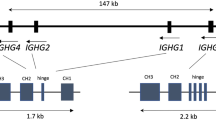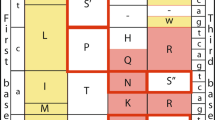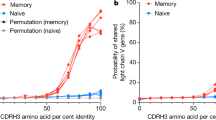Abstract
Analysis of human and mouse immunoglobulins has shown that five of six hypervariable regions that form the antigen binding site have a small repertoire of main chain conformations (canonical structures). Cartilaginous fishes are the most distantly related species to humans known to have an immune system, their evolutionary lines having diverged 450 million years ago. An analysis of VH and Vκ sequences from these fishes shows that all the main chain structures in their L1, L2, H1 and H2 hypervariable regions, and one of those in the L3 region, are the same as those most commonly found in human and mouse. This implies that the canonical structures occurring most commonly in hypervariable regions arose very early in the stages of the evolution of the immune system.
This is a preview of subscription content, access via your institution
Access options
Subscribe to this journal
Receive 12 print issues and online access
$189.00 per year
only $15.75 per issue
Buy this article
- Purchase on Springer Link
- Instant access to full article PDF
Prices may be subject to local taxes which are calculated during checkout
Similar content being viewed by others
References
Chothia, C. & Lesk, A.M. Canonical structures for the hypervariable regions of immunoglobulins. J. molec. Biol. 196, 901–917 (1987).
Chothia, C. et al. Conformations of immunoglobulin hypervariable regions. Nature 342, 877–883 (1989).
Chothia, C. et al. Structural repertoire of the human VH segments. J. molec. Biol. 227, 799–817 (1992).
Wu, S. & Cygler, M. Conformation of complimentary determining region - L1 loop in murine IgG λ light chain extends the repertoire of canonical forms. J. molec. Biol. 229, 597–601 (1993).
Litman, G.W. et al. Phylogenetic diversification of immunoglobulin genes and the antibody repertoire. Molec. Biol. Evol. 10, 60–72 1993).
Tomlinson, I.M., Walter, G., Marks, J.D., Llewelyn & Winter, G. The repertoire of human germline VH sequences reveals about fifty groups of VH segments with different hypervariable loops. J. molec. Biol. 227, 776–798 (1992).
Matsuda, M. et al. Structure and physical map of 64 variable segments in the 3′ 0.8-megabase region of the human immunoglobulin heavy-chain locus. Nature Genet. 3, 88–94 (1993).
Cook, G.P. et al. A map of the human immunoglobulin VH locus completed by analysis of the telomeric region of chromosome 14q. Nature Genet. 7, 162–168 (1994).
Schable, K.F. & Zachau, H.-G. The variable genes of the human immunoglobulin κ locus. Biol. Chem. Hoppe-Seyler 374, 1001–1022 (1993).
Kobubu, K., Litman, R., Shamblott, M.J., Hinds, K. & Litman, G.W. Diverse organization of immunoglobulin VH gene loci in a primitive vertebrate. EMBO J. 7, 3413–3422 (1988).
Hinds-Frey, K.R., Nishikata, H., Litman, R.T. & Litman, G.W. Somatic variation precedes extensive diversification of germline sequences and combinatorial joining in the evolution of immunoglobulin heavy chain diversity. J. exp. Med. 178, 815–824 (1993).
Harding, F.A., Cohen, N. & Litman, G. W. Immunoglobulin heavy chain organization and complexity in the skate, Raja erinacea. Nucleic Acids Res. 18, 1015–1020 (1990).
Harding, F.A., Amemiya, C.T., Liman, R.T., Cohen, N. & Litman, G.W. Two distinct immunoglobulin heavy chain isotypes in a primitive cartilaginous fish, Raja erinacea. Nucleic Acids Res. 18, 6369–6376 (1990).
Vasquez, M., Mizuki, N., Flajnik, M.F., McKinney, E.C. & Kasahara, M. Nucleotide sequence of a nurse shark immunoglobulin heavy chain cDNA clone. Molec. Immunol. 29, 1157–1158 (1992).
Greenberg, A.S., Steiner, L., Kasahara, M & Flajnik, M.F. Isolation of a shark immunoglobulin light chain cDNA clone encoding a protein resembling mammalian κ light chains: implications for the evolution of light chains. Proc. natn. Acad. Sci. U.S.A. 90, 10603–10607 (1993).
Sanger, F., Nicklen, S. & Coulson, A.R. DNA sequencing with chain-terminating inhibitors. Proc. natn. Acad. Sci. U.S.A. 74, 5463–5467 (1977).
Rast, J.P. et al. Immunoglobulin light chain class mulitiplicity and alternative organizational forms in early vertebrate phylogeny. Immunogenetics 40, 83–99, (1994).
Tramontano, A., Chothia, C. & Lesk, A.M. Framework residue 71 is a major determinant of the position and conformation of the second hypervariable region in the VH domains of immunoglobulins. J. molec. Biol. 215, 175–182 (1990).
Max, E.E. Molecular genetics of immunoglobulins. in Fundamental Immunology 3rd ed., (ed. W.E. Paul, Raven Press, New York; 1993).
Tonegawa, S. Somatic generation of antibody diversity. Nature 302, 575–581 (1983).
Hinds, K.R. & Litman, G.W. Major reorganization of immunoglobulin VH segmental elements during vertebrate evolution. Nature 320, 546–549 (1986).
Author information
Authors and Affiliations
Rights and permissions
About this article
Cite this article
Barré, S., Greenberg, A., Flajnik, M. et al. Structural conservation of hypervariable regions in immunoglobulins evolution. Nat Struct Mol Biol 1, 915–920 (1994). https://doi.org/10.1038/nsb1294-915
Received:
Accepted:
Issue Date:
DOI: https://doi.org/10.1038/nsb1294-915
This article is cited by
-
Analysis of the expressed heavy chain variable-region genes of Macaca fascicularis and isolation of monoclonal antibodies specific for the Ebola virus' soluble glycoprotein
Immunogenetics (2005)
-
Germline antibody recognition of distinct carbohydrate epitopes
Nature Structural & Molecular Biology (2003)
-
Crystal structure of a camel single-domain VH antibody fragment in complex with lysozyme
Nature Structural & Molecular Biology (1996)
-
Synthetic human antibodies
Nature Medicine (1995)



